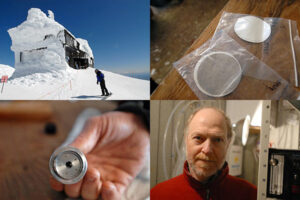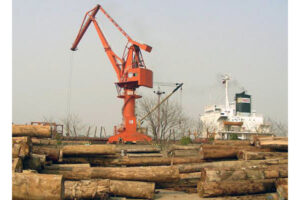
MOUNT BACHELOR, Oregon – At more than 9,000 feet along the crest of Oregon’s Cascade mountain range, the top of this snow-covered peak normally enjoys some of America’s cleanest air. So when sensitive scientific instruments picked up ozone – the chief component of smog – at levels higher than downtown Los Angeles and well above health safety limits set by the Environmental Protection Agency in late April, scientists took note.
Measurements of particulate matter – tiny bits of dust and black carbon linked with heart disease and lung cancer – reached one-third of the EPA safety threshold and counts of mercury – a potent neurotoxin – spiked.
Besides fouling the sky for skiers on the mountain, scientists working in a makeshift laboratory on the peak were concerned because the pollution plume is evidence of an increasingly large cloud of toxic substances carried by the jet stream across the Pacific Ocean from China. China’s decades-long spurt of unprecedented economic growth has not only made it the world’s top consumer of many commodities but also its top producer of pollutants including carbon dioxide, particulate matter, mercury, and nitrous oxide – a chemical compound that in sunlight can combine with oxygen to produce ozone.
China surpassed the United States as the world’s top emitter of carbon dioxide, the most important manmade gas causing climate change, in 2006. In 2009, China contributed a quarter of the world’s total carbon dioxide from energy consumption, according to the U.S. Energy Information Administration.
China’s nitrous oxide emissions have followed a similar trajectory, increasing 55 percent between 2001 and 2006, and Chinese pollution now accounts for “a little under ten percent” of the U.S. average for particulate matter and for one third of all mercury emissions around the world, according to Dan Jaffe, an atmospheric chemist at the University of Washington-Bothell who runs the Mount Bachelor observatory.
By dint of its size and rapid economic growth, China’s emissions are likely to surge over coming years and regulators increasingly worry that Chinese pollution will undercut state efforts to meet federal environmental regulations. The EPA’s ozone standard, for example, has fallen from 120 parts per billion in the 1970s, to 75 parts per billion, an expression of the ratio above which the agency considers ozone to be unsafe. Last year, EPA regulators said they expect to further reduce the limit to between 60 and 70 parts per billion.
At the top of Mount Bachelor Jaffe and his team have found ozone levels averaging 50 parts per billion, a large portion of which Jaffe attributes to Chinese pollution. “The level the EPA says is safe is getting closer and closer to what’s blowing across the ocean,” he says, standing in a cramped lab at the top of mountain.
“Ozone is a good example of how we’re living in a world full of more airborne pollutants.”
EARLY WARNINGS
For American scientists, the recognition that China’s growth is fouling U.S. skies has come slowly. When Jaffe began studying atmospheric pollution in the late nineteen eighties, “no one thought that Asian pollution could be a problem,” he says. “They thought it was just too far away.”
Then, in 1994, he came across a computer model that suggested Chinese pollution was reaching the Arctic. Jaffe wondered if the jet stream – the high-altitude winds that blow from west to east around the planet – could be carrying some of that pollution into the United States.
With a grant from the National Science Foundation, Jaffe began taking air samples on Cheeka Peak, a 1,598-foot mountain on the tip of Washington’s Olympic Peninsula. In 1997, he was looking through the data when he had what he calls a “eureka moment”: He saw for the first time “that there was a real difference when the air was coming out of Asia.”
While the data proved that Chinese pollutants could be carried into the United States, most scientists considered the news more interesting than important. But as China has continued its three-decade-long economic rise, the amount of pollution flowing west has spiked.
A 2010 study by David Parrish, the director of the chemical sciences laboratory at the government-run National Oceanic and Atmospheric Administration, found that more than three-quarters of the ozone in parts of California’s Sacramento Valley was blown in from Asia. Roughly half of that pollution was created by natural causes, including lightening storms and wildfires, but the rest was caused by human activities – largely burning fossil fuels.
“I can look and see that ozone is probably a factor of three higher than it was in pre-industrial times throughout the northern mid-latitudes and that’s because of anthropogenic sources,” Parrish says. “That has an impact on health.”
Several studies of Oregon’s Willamette River have found dangerously high levels of mercury and polychlorinated biphenyls, compounds that have been linked to cancer and liver damage. The U.S. federal government banned the production of PCBs in 1977 and Bruce Hope, the senior environmental toxicologist for Oregon’s Department of Environmental Quality, believes much of what scientists are finding now was carried by the jet stream from China before settling along the West Coast.
Mercury pollution has been a particularly serious problem. A 2006 study found that one fifth of the mercury in the Willamette had come from foreign sources. Most of that probably came from China, Hope says.
The problem of foreign pollution has become more serious as the number of factories and power plants in Oregon that produce mercury pollution has fallen. Hope estimates that “less than five percent” of mercury pollution in the Willamette now comes from such sources and says the state may have to convince foreign countries – largely China – to clean up if they want to make the river safer for fishermen.
“I don’t think people have realized that we’ve externalized our environmental costs to China and that they are using chemicals there that are illegal here to make the things we buy,” he says.
In terms of sheer scale, China’s greatest pollutant to the United States is dust – scientifically called particulate matter. Like the great Dust Bowl days of American history, China has been plagued with huge storms of sand and grit that have gotten worse as the country has drawn down its aquifers and overtaxed its lands.
Huge storms can pick up some of that dust and fling it across the Pacific. A 2001 Asian storm dumped 110,000 metric tons of dust over the United States, an amount equivalent to all the particulate matter released on an average day in the country. Cities including Atlanta, Georgia issued health alerts as the particles settled to the ground.
“The dust was really obvious and it was really obvious where it came from,” Jaffe says. “It made us understand the global pollution flows better.”
HEALTH FEARS
For scientists, the greatest concern about the growing plume of Chinese pollution is the health of people downwind. The World Health Organization estimates that 41,200 Americans die each year due to exposure to elevated concentrations of particulate matter.
Ozone poses the classic dangers of urban smog – heart and lung disease – while mercury is a known to disrupt fetal brain development and has been linked to autism and Alzheimer’s disease. Data collected by the U.S. Centers for Disease Control and Prevention showed an increasing level of mercury in the blood of American women between 1999 and 2006.
Most of those problems are caused by local sources including car exhaust and factory emissions. But the federal government has begun to look more closely at how distant foreign pollution can affect human health.
The EPA supported a report last year entitled “Global Sources of Local Pollution,” the first large attempt by the agency to quantify the problem. One conclusion was that foreign pollution into the United States will increase and officials should work with foreign nations to understand and control the growth.
For Jaffe, who participated in writing the report, the significance is obvious: To control pollution, Americans need to think globally.
“This is a problem we need to address,” he says. “We only have one planet, and we all share it.”




